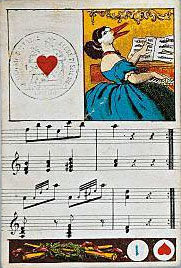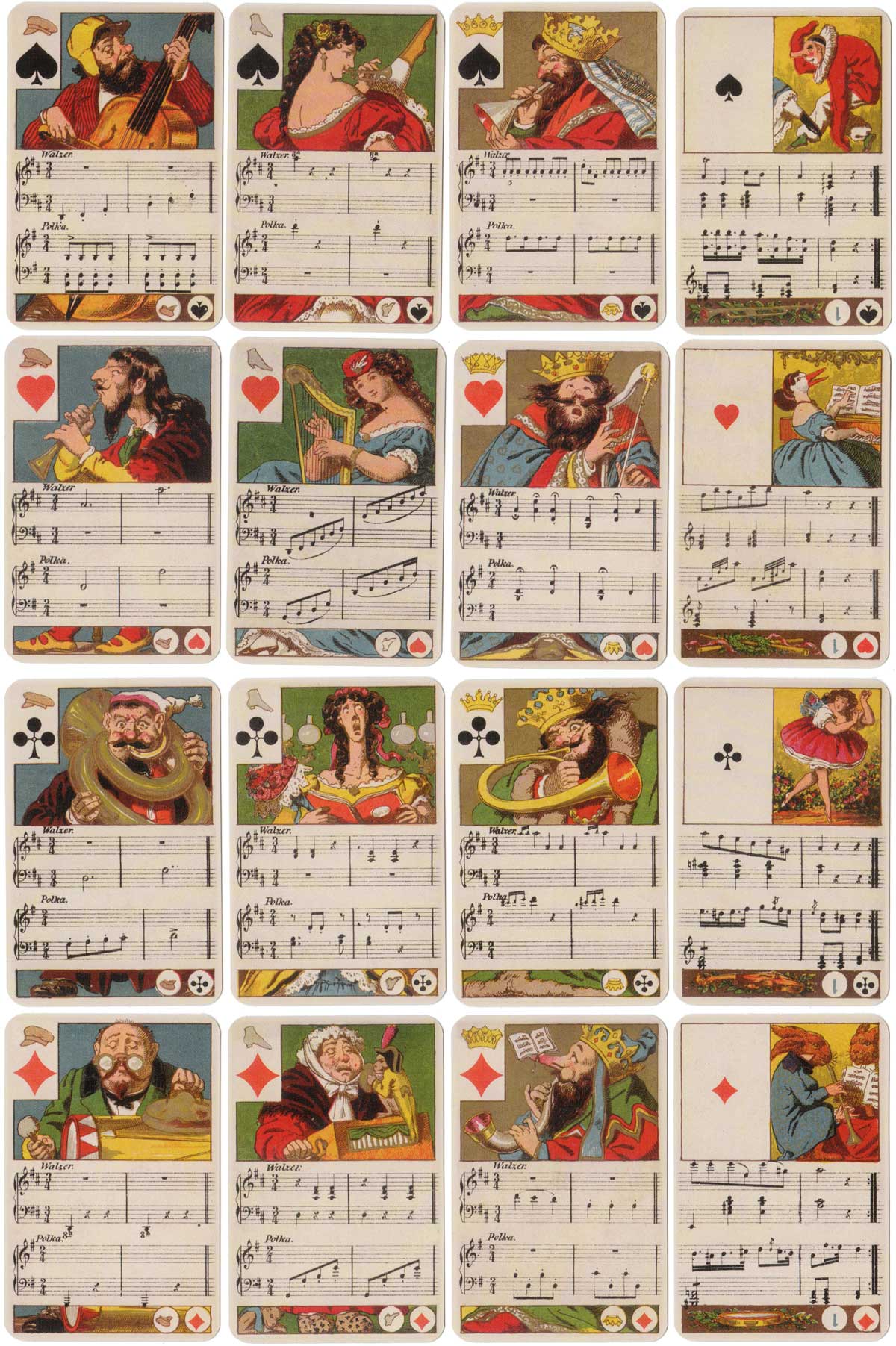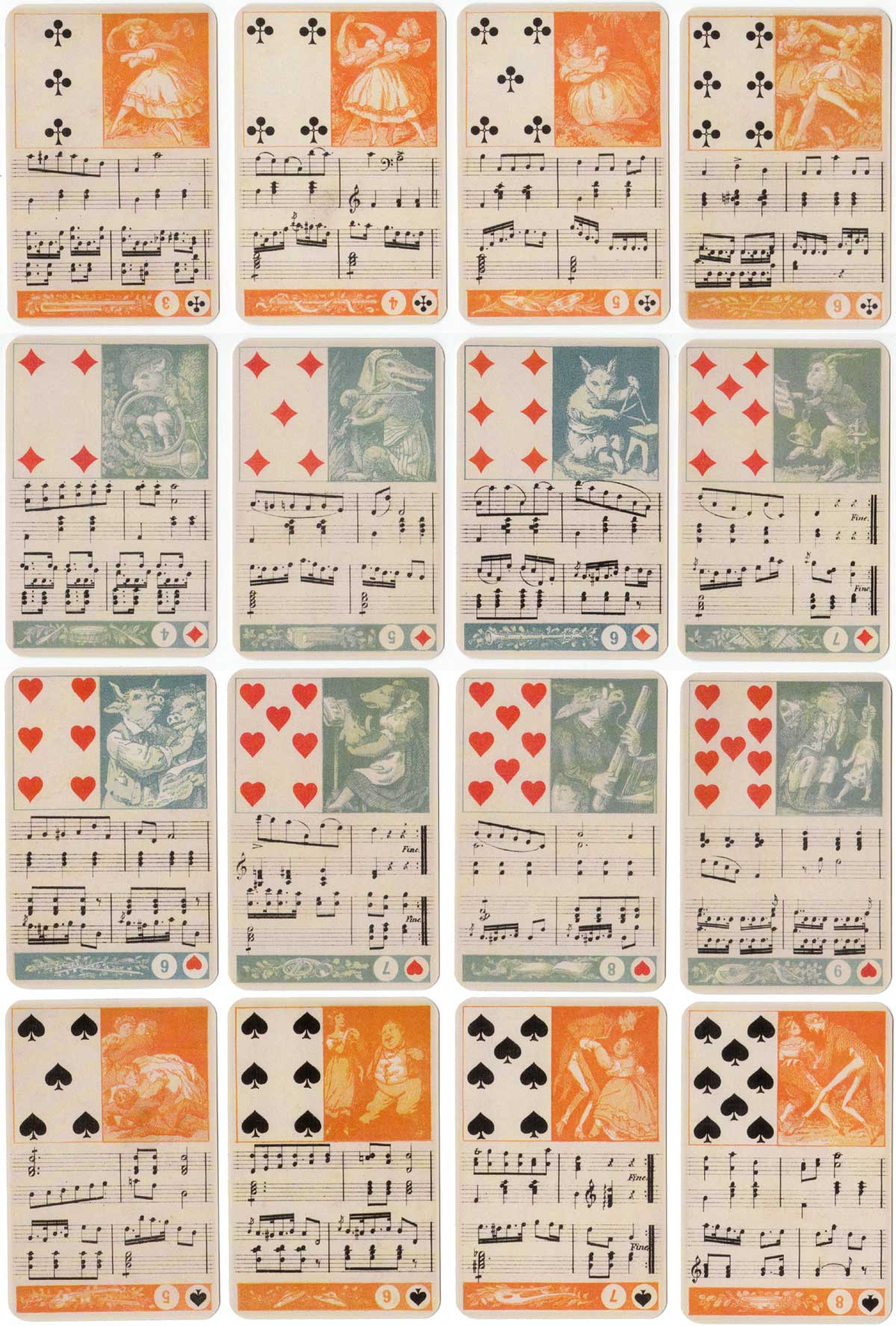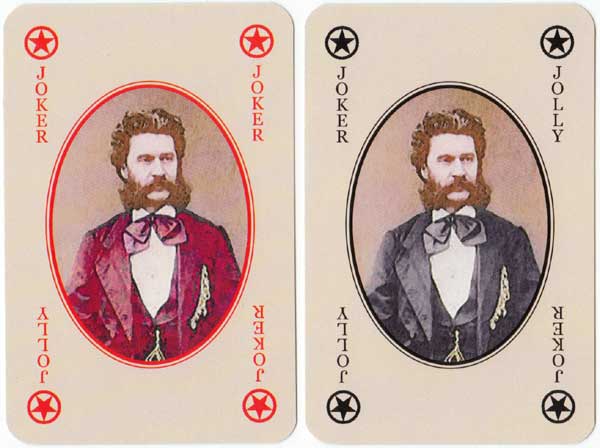Musikalisches Kartenspiel
Facsimile of Dondorf’s “Musikalisches Kartenspiel” (c.1862) published by Lo Scarabeo, 2004
Musical playing cards were popular since the 18th century, and dances were favourites. This facsimile of Dondorf’s “Musikalisches Kartenspiel” (c.1862) was published by Lo Scarabeo in 2004 as a homage to the Strauss dynasty which contributed significantly to the development of popular music with such pieces as “Blue Danube”. The court cards feature comical musicians, often with red noses, along with two bars from classical dance scores such as the waltz and polka. The images are in full colour on the 4 aces and 12 court cards, and muted tones on the number cards; the red suited number cards show animal musicians, the black ones feature dancers. The bottom of each card also features a suit symbol and rank indicator thus making the deck double-ended for play. See the Box►

Above: original ace of hearts with tax stamp.


Above: facsimile of Dondorf’s “Musikalisches Kartenspiel” (c.1862) published by Lo Scarabeo, 2004. The facsimile edition contains two jokers plus six extra description cards, not part of the original edition which contained 52 cards only. Images courtesy Rex Pitts.
The artwork appears to be by the same draughtsman who produced Cartes Comiques►


By Rex Pitts (1940-2021)
Member since January 30, 2009
Rex's main interest was in card games, because, he said, they were cheap and easy to get hold of in his early days of collecting. He is well known for his extensive knowledge of Pepys games and his book is on the bookshelves of many.
His other interest was non-standard playing cards. He also had collections of sheet music, music CDs, models of London buses, London Transport timetables and maps and other objects that intrigued him.
Rex had a chequered career at school. He was expelled twice, on one occasion for smoking! Despite this he trained as a radio engineer and worked for the BBC in the World Service.
Later he moved into sales and worked for a firm that made all kinds of packaging, a job he enjoyed until his retirement. He became an expert on boxes and would always investigate those that held his cards. He could always recognize a box made for Pepys, which were the same as those of Alf Cooke’s Universal Playing Card Company, who printed the card games. This interest changed into an ability to make and mend boxes, which he did with great dexterity. He loved this kind of handicraft work.
His dexterity of hand and eye soon led to his making card games of his own design. He spent hours and hours carefully cutting them out and colouring them by hand.
Related Articles

Pathé Marconi
Special promotion pack for French record company Pathé Marconi.

Late flowering of the Lyon pattern
Faustino Solesio’s late version of the Lyon pattern from about 1870.

CARD-AB Miltenberg
Illustrations by Rita Stern depicting notable landmarks and scenes from the town of Miltenberg in Ge...

Czech National Patterns by S.D. Modiano
Modiano produced cards with the Prague and Trappola patterns in the early 20th century.

New Altenburg Skat cards – German DDR Pattern
Authentic Altenburger Skat cards with German suits (Acorns, Hearts, Leaves, Bells).

Emilio Tadini playing cards
Beautiful dreamlike playing card designs by Emilio Tadini.

Banjo Cards
Images of the peg heads from 4-string banjos from Akira Tsumura’s renowned collection.

German Travel Cards
A travel-themed educational deck helping American tourists visiting Germany.

Austrian Tarock by S.D. Modiano
Modiano’s Austrian Tarock with country scenes has been in production for over 100 years.

Songs with Flute accompaniment
Eighteenth century English engraved cards with music for voice and flute.

Briefmarken-Quartett
Quartet game featuring postage stamps from the Zones of Occupation in post-WWII Germany.

Le carte da gioco Arcimboldo
Courts and suit-signs inspired by the works of the Italian Renaissance painter, Giuseppe Arcimboldo....

22 Pittori in 22 Arcani
Collaborative Tarot with contributions from 22 different Italian artists including Menegazzi and Tav...

IG Chemie Papier Keramik
Promotional pack designed by Karl-Heinz Schroers for a German trade union with comical bears on the ...

Justice playing cards
Ethical concepts in a deck produced by Riccardo Conturbia’s Passione Playing Cards Ltd.

Alan Tarot Deck
Reprint of a Tarock pack originally designed by Argio Orell for the Austrian Lloyd shipping company....
Most Popular
Our top articles from the past 28 days

